
Old Blenheim Bridge was a wooden covered bridge that spanned Schoharie Creek in North Blenheim, New York, United States. With an open span of 210 feet (64 m), it had the second longest span of any surviving single-span covered bridge in the world. The 1862 Bridgeport Covered Bridge in Nevada County, California, currently undergoing repairs due to 1986 flooding is longer overall at 233 feet (71 m) but is argued to have a 208 feet (63 m) clear span. The bridge, opened in 1855, was also one of the oldest of its type in the United States. It was destroyed by flooding resulting from Tropical Storm Irene in 2011. Rebuilding of the bridge commenced in 2017 and was completed in 2018.

The Leatherwood Station Covered Bridge is a single span double Burr Arch Truss covered bridge structure that was built by Joseph A. Britton & Son in 1899. Originally it had sandstone abutments but when it was moved to Billie Creek Village they were replaced with concrete abutments with sandstone showing.
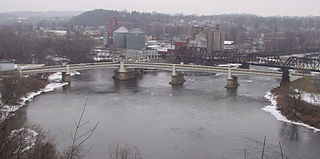
The Zanesville Y-Bridge is a historic Y-shaped three-way bridge that spans the confluence of the Licking and Muskingum Rivers in downtown Zanesville, Ohio. It carries the traffic of U.S. Route 40, as well as Linden Avenue.

Tinkers Creek Aqueduct is an aqueduct that was constructed to bridge the Ohio and Erie Canal over Tinkers Creek near its confluence with the Cuyahoga River in Valley View, Ohio. It is a relatively rare surviving example of an Ohio and Erie Canal aqueduct. It was originally constructed in 1825-1827 by, and re-built due to flood damage in 1845 and 1905. Tinkers Creek Aqueduct was included in a National Historic Landmark district established in 1966, and it was separately listed on the National Register of Historic Places in 1979. The original Tinkers Creek Aqueduct was a wood plank, steel truss, and Ashlar-sandstone structure constructed in 1827, south of the present aqueduct's location. Cuyahoga River and Tinkers Creek flooding caused continual damage to the original aqueduct, so successive structures were built in 1845 and 1905 in the present location. Today, Tinkers Creek Aqueduct is the only aqueduct which remains of the four original aqueducts in the Cuyahoga Valley. Of Furnace Run Aqueduct, Mill Creek Aqueduct, Peninsula Aqueduct, and Aqueduct; Mill Creek Aqueduct, of newer construction, is the only aqueduct which still carries Ohio and Erie Canal water. After 102 years of flooding, weathering, and deterioration, Tinkers Creek Aqueduct was removed in 2007. The National Park Service is currently working on Phase II of the project to reconstruct it from newer materials.
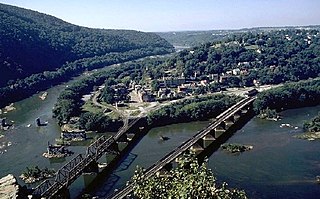
The B & O Railroad Potomac River Crossing is a 15-acre (6.1 ha) historic site where a set of railroad bridges, originally built by the Baltimore and Ohio Railroad, span the Potomac River between Sandy Hook, Maryland and Harpers Ferry, West Virginia. The site was added to the National Register of Historic Places on February 14, 1978, for its significance in commerce, engineering, industry, invention, and transportation.
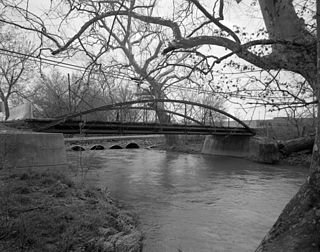
The Crum Road Bridge is a historic bridge near Frederick, Frederick County, Maryland, United States. It spanned Israel Creek southeast of Walkersville. The bridge is an iron bowstring pony bridge that is 62 feet (19 m) in length and 15.8 feet (4.8 m) in width. The Crum Road Bridge was built on or about 1875, and was probably constructed by the King Iron Bridge Company of Cleveland, Ohio.

The Baltimore & Ohio Railroad Bridge, Antietam Creek was a timber trestle bridge near Keedysville, Washington County, Maryland, United States. It carried the Washington County branch of the Baltimore and Ohio Railroad, later part of CSX Transportation, over the ravine formed by the Antietam Creek northwest of Keedysville. The wooden bridge, constructed about 1867, was approximately 400 feet (120 m) in length and was supported by a series of timber bents resting on concrete sills. CSX abandoned the railroad line in the late 1970s or 1980s.

The Zion – Mount Carmel Highway is a 25-mile (40 km) long road in Washington and Kane counties in southern Utah, United States, that is listed on the National Register of Historic Places and is a National Historic Civil Engineering Landmark.
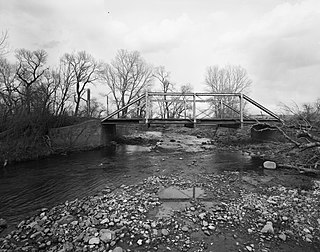
The ECS Bridge over Big Goose Creek was a bridge near Sheridan, Wyoming, that was built in 1914. It was a Pratt pony truss bridge built by the Canton Bridge Company of Canton, Ohio. The Canton Bridge Company built four steel bridges in Wyoming in 1914; when nominated to the National Register of Historic Places in 1982, the ECS Bridge was the only one of these surviving in its original location. It was 50 feet (15 m) long and 15 feet (4.6 m) wide.

Skippack Bridge, also known as Montgomery County Bridge No. 142, is a historic stone arch bridge located near Evansburg in Lower Providence Township, Montgomery County, Pennsylvania. The bridge was built in 1792 and repaired in 1874. It has eight spans, is 33-foot (10 m) wide, with an overall length of 202-foot (62 m). The bridge carries Germantown Pike across Skippack Creek.
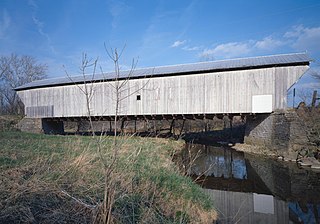
The Harshman Covered Bridge near Fairhaven, Ohio, was built in 1894 by Everett S. Sherman. It was listed on the National Register of Historic Places in 1976. It was documented by the Historic American Engineering Record (HAER) in 2003.
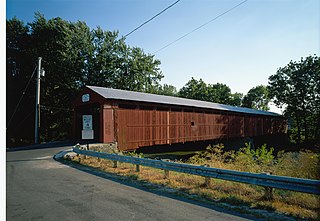
The Eldean Covered Bridge is a historic covered bridge spanning the Great Miami River in Miami County, Ohio north of Troy. Built in 1860, it is one of the nation's finest surviving examples of a Long truss, patented in 1830 by engineer Stephen H. Long. At 224 feet (68 m) in length for its two spans, it is the longest surviving example of its type. It was listed on the National Register of Historic Places in 1975, and was designated a National Historic Landmark in 2016.

The Cataract Falls Covered Bridge is a covered bridge that spans Mill Creek in Lieber State Recreation Area, Owen County, Indiana. Built in 1876 by the Smith Bridge company of Toledo, Ohio, it was at one time one of the most famous and photographed covered bridges in the United States. It is the only remaining one in Owen County.

Best's Covered Bridge(akaSwallow's Bridge) is a historic covered bridge in West Windsor, Vermont, that carries Churchill Road over Mill Creek, just south of Vermont Route 44. Built in 1889, it is an architecturally distinctive laminated arch structure with a post-and-beam superstructure. It was listed on the National Register of Historic Places in 1973.

The Station Road Bridge, near Brecksville, Ohio, was built in 1882. It spans the Cuyahoga River between Cuyahoga County and Summit County, Ohio. It was listed on the National Register of Historic Places in 1979.
The historic bridges at the Lancaster campus of Ohio University were moved to the campus and sit about 100 yards (91 m) apart. The bridges were built in 1881 and 1884–85 very close to each other, both crossing Poplar Creek, and while the first-built is a wood-and-steel covered bridge and the second-built is all-steel, they are similar in design. Original and current locations of both bridges may be seen in OpenStreetMap linked at right.

The Knowlton Covered Bridge, near Rinard Mills, Ohio, was built around 1860. It was listed on the National Register of Historic Places in 1980. It was decommissioned shortly after. Also known as the Long Covered Bridge, it is a Burr arch truss bridge.
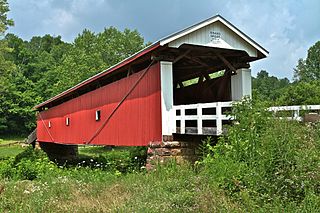
The Rinard Covered Bridge, near Marietta, Ohio, was built in 1876. It was listed on the National Register of Historic Places in 1976.
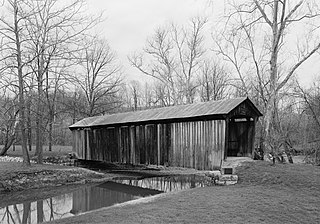
The Salt Creek Covered Bridge, near Norwich in Perry Township, Muskingum County, Ohio, was built in 1876. It was listed on the National Register of Historic Places in 1974.

The Red Oak Creek Covered Bridge carries Covered Bridge Road across Red Oak Creek north of Woodbury, Georgia. It was listed on the National Register of Historic Places in 1973.



















